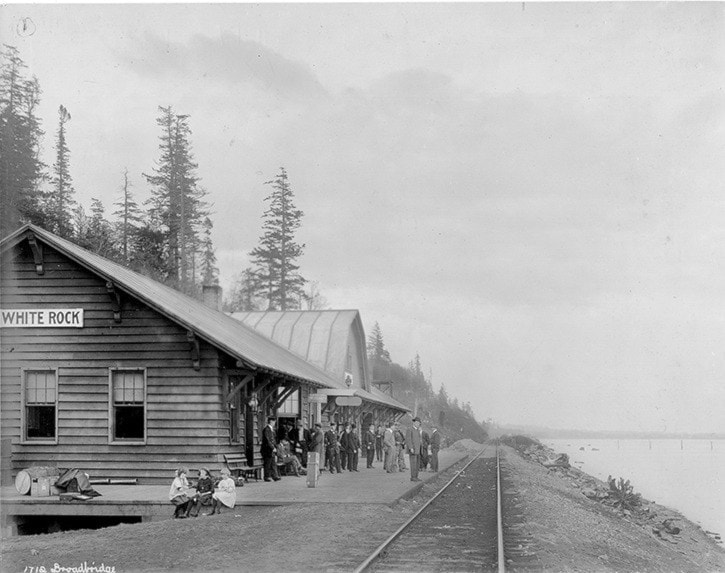We are celebrating the 100th birthday of our museum and archives building this year, and invite everyone to join with us in a salute to this venerable White Rock icon.
Built as a railway depot, it has adapted to serve other purposes but remains the most recognizable building on the waterfront.
Originally opened on Jan. 1, 1913, as the Great Northern Railway station, it was turned over to the city in 1975 when trains no longer stopped at White Rock.
The building was of rare design in that it contained customs and immigration facilities, as well as railway offices.
It soon became the hub of a booming community.
But, as archives volunteer Tom Saunders points out, the new railway depot was one of several significant developments in 1913, a year that he terms “a genesis year for our city.”
The GNR rail line, rerouted along the shore of Semiahmoo Bay, became operational in March 1909. By 1913, 10 passenger trains a day – five in each direction – stopped in White Rock during the summer, triggering a land boom.
The potential danger of accidents involving increasing numbers of beachgoers prompted the building of a subway under the GNR railway at Elm Street.
With the availability of the railway to haul logs, the Campbell River Lumber Company (whose mill at Hazelmere had recently burned) leased 36 acres of Semiahmoo Reserve land and built a state-of-the-art mill, which opened in September 1913, eventually employing 250 men.
Real estate firms abounded, with familiar local names of Thrift, Vidal and Hughes among them, some having purchased land in anticipation of the relocation of the railway line. The White Rock ‘townsite’ sales agency, based in New Westminster, employed a resident White Rock manager.
Lots that had been offered for sale for $25 in 1907 were, in 1913, selling for an average price of $1,500.
The BC Magazine reported that 150 permanent homes had been erected in the past two years. The British Columbian newspaper of New Westminster predicted that 3,000 campers would make White Rock their summer home.
This influx of summer residents required provisions and accommodation. A large hotel and several  convenience food outlets lined the seafront road, offering hot water for sale along with confections and the inevitable fish and chips.
convenience food outlets lined the seafront road, offering hot water for sale along with confections and the inevitable fish and chips.
Understandably, it was not as easy to provide newly arrived permanent families with basic amenities. However, the property for the White Rock Elementary School was purchased from pioneer John Roper in 1913, with the new school opening the following year.
White Rock’s first church, the precursor of First United, constructed on Prospect Avenue with funds raised mainly by the Ladies’ Aid, was dedicated in August.
The Sunday-school population had increased from fewer than 15 in 1912 to 50 in 1913.
Formed in 1910 by local men, the rudimentary White Rock Water Works Company was upgraded in 1913 and formally registered, enduring to earn the distinction of being the last privately owned water works company in B.C.
With an eye to requests of vacationers as much as a convenience for residents, a public telephone call office was installed in David Hughes’ real estate office on the seafront road (now Marine Drive). Although the pole line was set up, electricity was a more intricate affair, complicated by absent landowners.
Well aware of White Rock’s newsworthiness, in March Charles E. Sands began publication of Surrey’s sole newspaper, The Semiahmoo Gazette, a unique local voice until its merger with the newly established Surrey Leader in 1929.
Because of its geographical position, White Rock interested influential men on both sides of the international border in development schemes.
In 1913, J. D. Hazen, the Canadian Minister of Fisheries and Marine visited White Rock precipitating the construction of the White Rock pier in 1914.
Unfortunately, the euphoria of 1913 was soon sidelined by the demands of the First World War.
“White Rock contributed more men to the cause of liberty than any other place of its size in the Fraser Valley,” claimed the White Rock Improvement League.
But, you’re right, Tom, 1913 was a banner year for White Rock.
The Peninsula’s best-known mother-and-son historians, Lorraine and Hugh Ellenwood, are dedicated to preserving history through the White Rock Museum & Archives. Call 604-541-2225, or email whiterockarchives@telus.net
